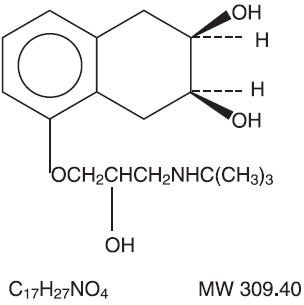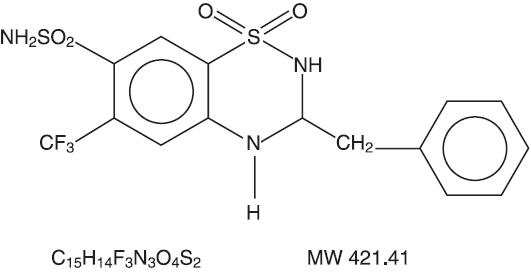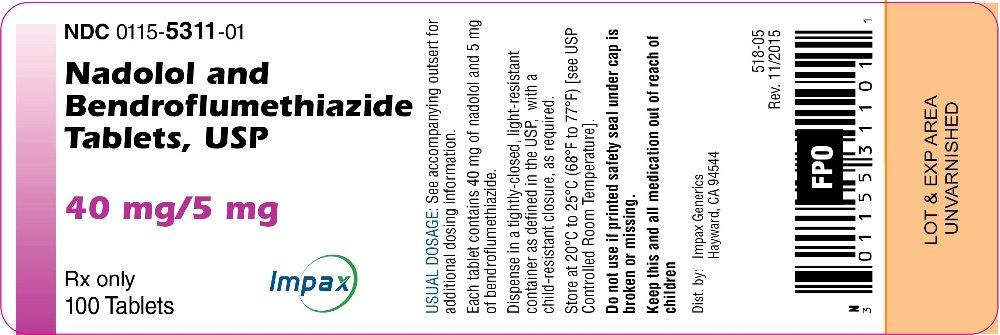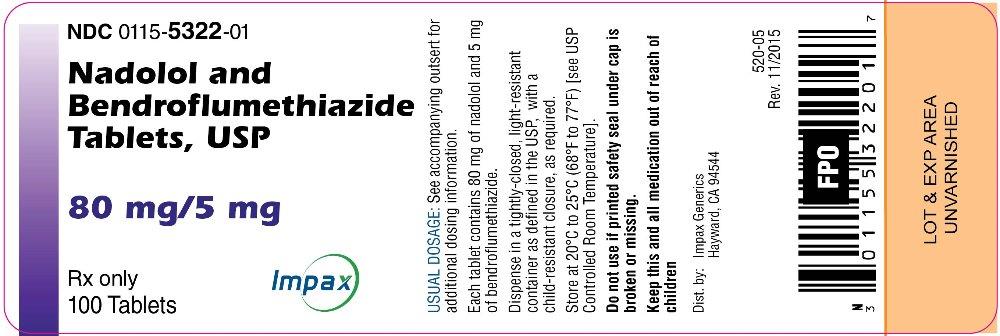Drug Catalog - Product Detail
NADOLOL/BENDROFLUMETHIAZIDE,USP TB 80/5MG 100
| NDC | Mfr | Size | Str | Form |
|---|---|---|---|---|
| 00115-5322-01 | IMPAX GENERICS | 100 | 80-5MG | TABLET |
PACKAGE FILES




Generic Name
Substance Name
Product Type
Route
Application Number
Description
DESCRIPTION Nadolol and bendroflumethiazide tablets for oral administration combine two antihypertensive agents: nadolol, a nonselective beta-adrenergic blocking agent, and bendroflumethiazide, a thiazide diuretic-antihypertensive. Each tablet contains 40 mg or 80 mg nadolol combined with 5 mg bendroflumethiazide. Inactive ingredients: croscarmellose sodium, hypromellose (type 2910), lactose monohydrate, magnesium stearate, mannitol, microcrystalline cellulose, pregelatinized starch and talc. Nadolol Nadolol is a white crystalline powder. It is freely soluble in ethanol, soluble in hydrochloric acid, slightly soluble in water and in chloroform, and very slightly soluble in sodium hydroxide. Nadolol is designated chemically as 1-( tert -butylamino)-3-{(5,6,7,8-tetrahydro- cis -6,7-dihydroxy-1-naphthyl)oxy}-2-propanol. Structural formula: Chemical Structure Bendroflumethiazide Bendroflumethiazide is a white crystalline powder. It is soluble in alcohol and in sodium hydroxide, and insoluble in hydrochloric acid, water, and chloroform. Bendroflumethiazide is designated chemically as 3-benzyl-3,4-dihydro-6-(trifluoromethyl)-2 H -1,2,4-benzothiadiazine-7-sulfonamide 1,1-dioxide. Structural formula: Chemical Structure
How Supplied
HOW SUPPLIED Nadolol and bendroflumethiazide tablets, 40 mg/5 mg, contain 40 mg nadolol combined with 5 mg bendroflumethiazide, and are white to off-white, round, bi-convex tablets debossed with "G" bisect "531" on one side and plain on the other. Bottles of 100 NDC 0115-5311-01 Bottles of 500 NDC 0115-5311-02 Nadolol and bendroflumethiazide tablets, 80 mg/5 mg, contain 80 mg nadolol combined with 5 mg bendroflumethiazide, and are white to off-white, round, bi-convex tablets debossed with "G" bisect "532" on one side and plain on the other. Bottles of 100 NDC 0115-5322-01 Bottles of 500 NDC 0115-5322-02 Storage Store at 20°C to 25°C (68°F to 77°F) [see USP Controlled Room Temperature]. Dispense in a tightly-closed, light-resistant container as defined in the USP, with a child-resistant closure, as required.
Indications & Usage
INDICATIONS Nadolol and bendroflumethiazide tablets are indicated for the treatment of hypertension, to lower blood pressure. Lowering blood pressure reduces the risk of fatal and nonfatal cardiovascular events, primarily strokes and myocardial infarctions. These benefits have been seen in controlled trials of antihypertensive drugs from a wide variety of pharmacologic classes including the classes to which this drug principally belongs. There are no controlled trials demonstrating risk reduction with nadolol and bendroflumethiazide tablets. Control of high blood pressure should be part of comprehensive cardiovascular risk management, including, as appropriate, lipid control, diabetes management, antithrombotic therapy, smoking cessation, exercise, and limited sodium intake. Many patients will require more than one drug to achieve blood pressure goals. For specific advice on goals and management, see published guidelines, such as those of the National High Blood Pressure Education Program's Joint National Committee on Prevention, Detection, Evaluation, and Treatment of High Blood Pressure (JNC). Numerous antihypertensive drugs, from a variety of pharmacologic classes and with different mechanisms of action, have been shown in randomized controlled trials to reduce cardiovascular morbidity and mortality, and it can be concluded that it is blood pressure reduction, and not some other pharmacologic property of the drugs, that is largely responsible for those benefits. The largest and most consistent cardiovascular outcome benefit has been a reduction in the risk of stroke, but reductions in myocardial infarction and cardiovascular mortality also have been seen regularly. Elevated systolic or diastolic pressure causes increased cardiovascular risk, and the absolute risk increase per mmHg is greater at higher blood pressures, so that even modest reductions of severe hypertension can provide substantial benefit. Relative risk reduction from blood pressure reduction is similar across populations with varying absolute risk, so the absolute benefit is greater in patients who are at higher risk independent of their hypertension (for example, patients with diabetes or hyperlipidemia), and such patients would be expected to benefit from more aggressive treatment to a lower blood pressure goal. Some antihypertensive drugs have smaller blood pressure effects (as monotherapy) in black patients, and many antihypertensive drugs have additional approved indications and effects (e.g., on angina, heart failure, or diabetic kidney disease). These considerations may guide selection of therapy. Nadolol and bendroflumethiazide tablets are not indicated for initial therapy of hypertension. If the fixed combination represents the dose titrated to the individual patient's needs, it may be more convenient than the separate components.
Dosage and Administration
DOSAGE AND ADMINISTRATION DOSAGE MUST BE INDIVIDUALIZED (SEE INDICATIONS ). NADOLOL AND BENDROFLUMETHIAZIDE TABLETS MAY BE ADMINISTERED WITHOUT REGARD TO MEALS. Bendroflumethiazide is usually given at a dose of 5 mg daily. The usual initial dose of nadolol is 40 mg once daily whether used alone or in combination with a diuretic. Bendroflumethiazide in nadolol and bendroflumethiazide tablets is 30 percent more bioavailable than that of 5 mg bendroflumethiazide tablets. Conversion from 5 mg bendroflumethiazide tablets to nadolol and bendroflumethiazide tablets represents a 30 percent increase in dose of bendroflumethiazide. The initial dose of nadolol and bendroflumethiazide tablets may therefore be the 40 mg/5 mg tablet once daily. When the antihypertensive response is not satisfactory, the dose may be increased by administering the 80 mg/5 mg tablet once daily. When necessary, another antihypertensive agent may be added gradually beginning with 50 percent of the usual recommended starting dose to avoid an excessive fall in blood pressure. Dosage Adjustment in Renal Failure Absorbed nadolol is excreted principally by the kidneys and, although nonrenal elimination does occur, dosage adjustments are necessary in patients with renal impairment. The following dose intervals are recommended: Creatinine Clearance (mL/min/1.73 m 2 ) Dosage Interval (hours) >50 24 31 to 50 24 to 36 10 to 30 24 to 48 <10 40 to 60
